Hanover Bald Eagle Blog # 17 - 2021
April 26, 2021
In partnership with Pennsylvania Game Commission and Comcast Business .
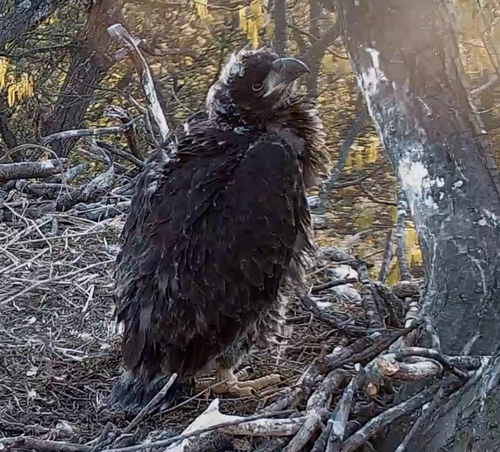
The appearance of the Hanover eaglet has changed rapidly over the course of the last few weeks, most notably in feather growth. Not long ago the youngster looked like a giant cotton ball. Now, they are nearly covered in brown feathers and they preen with diligence, just like the Hanover adults.
Feathers are necessary for many aspects of bird life and different feathers fulfill different needs. Some are specifically designed to help with insulation, while others protect against the elements, provide color, or make flight possible. These different types of feathers must develop at the right time and the right place -- along the bird’s body, that is.
The Hanover eaglet’s first feathers grew along the wing, back, and head, before appearing on the rest of the body. These tracks are called pterylae, and their arrangement differs between groups of birds depending on factors such as flight behavior and where the species lives. Feather tracks distribute feather weight across the bird’s body, and ensure that bare skin remains exposed between the tracks which allows the bird to cool off by dissipating heat. These bare tracks are called apterylae.
Birds need several types of feathers. To start, contour feathers cover the outside of the bird. Because they function as the first line of defense against the elements, contour feathers are quite literally zipped together through a complex structure of interlocking parts called barbules. The largest of the contour feathers are those that make up the wing, called remiges, which are further divided into primary and secondary feathers as shown below.
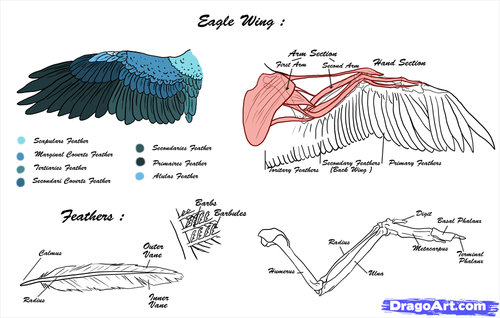
Labeled bones, feathers, and parts of the feather. Image credit: DragoArt.com
Coverts are rows of feathers that border the flight feathers and tail feathers. The coverts are critical because they provide color, pattern, insulation, and most importantly, they reduce friction by streamlining the shape of the bird’s wing.
Feathers can compliment bird lifestyles in fascinating ways. Some birds, like peacocks and birds of paradise grow elaborate ornamental feathers for use in courtship displays to attract a female. Owls have specialized fringed feathers on the edge of their wing to muffle their sound as they prowl through the night searching for prey. Some insectivorous birds like nighthawks have tiny feathers called rictal bristles, which are thought to function like whiskers or eyelashes, increasing the bird’s ability to detect insects and keep debris out of their eyes.
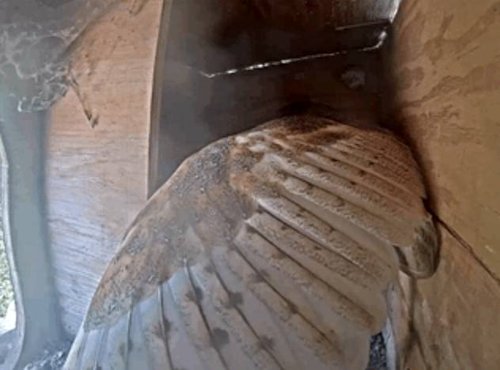
Beautiful Barn Owl Feathers from the Ramona Barn Owl Box.
Raptors and many seabirds possess a layer of feathers called body down for added insulation (your down jackets likely contain goose or synthetic down). This is different from the light colored natal down, which gave the Hanover eaglet their cotton ball look. This baby fluff, which grows from the same follicles that later produce contour feathers, only lasts about ten days. Afterwards, a similar but more sophisticated layer of down forms that will serve the eagle its whole life. Body down traps air and holds it against the bird’s body, providing a thermal barrier against the cold. (it’s no coincidence that down coats are a popular choice for avid outdoor recreators). After two weeks of age, eaglets are able to thermoregulate on their own with the help of their thermal down layer.
The Hanover eaglet’s wing and tail feathers won’t reach full length until they are ready to take their first flight, and even then, they may still have some growing left. Juvenile bald eagles have slightly longer flight feathers than adults, giving them a larger appearance. Those long feathers will be replaced by normal-length ones after the youngster’s first molt. Bald eagles do not reach full adult plumage with a white head and tail until five years of age, and as such, they are frequently mistaken for their all-brown cousin, the golden eagle. For more information on how to tell the difference between the two, visit this informative page.
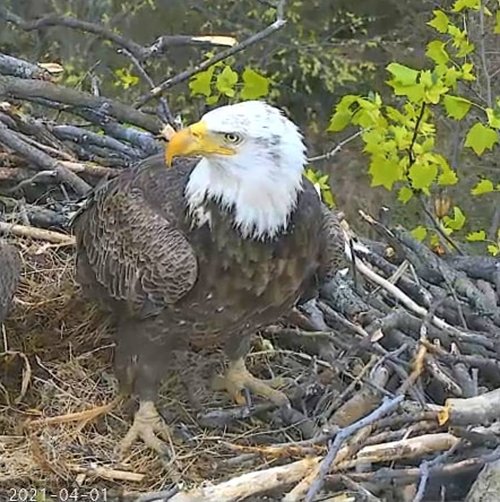
V5, a younger eagle in the National Arbatorium seen above can be identified as being less than 5 years old because they still have some darker feathers in their head plumage.
Feather damage can and does occur in the wild, either from entanglement, collisions, antagonistic interactions with other birds, or other physically demanding activities. Feathers, like mammal hairs, grow from follicles. The first stage of a feather is called a pin feather or blood feather because it has a blood supply. If a blood feather becomes damaged during growth, the bird can lose a lot of blood, and in the case of the Captiva nestling, sometimes die. The Clinic for the Rehabilitation of Wildlife (CROW) determined that the indirect cause of death for the Captiva nestling was rodenticide poisoning, even though the primary issues was a broken blood feather. Rodenticide prevents coagulation and the poor nestling likely bled to death. Read this article for more details on the Captiva nestling, and read this article to learn more about how rodenticide affects raptors and other wildlife.
Sources
Axelson, Rick (2021). Pin or Blood Feathers in Birds. Veterinary Centers of America.https://vcahospitals.com/know-your-pet/pin-or-blood-feathers-in-birds#:~:text=When%20a%20feather%20is%20pulled,like%20the%20feather%20shaft%20itself
Barsony, Melanie. The Art of Imping: The Dynamics of Raptor Feather Repair. Retrieved from 25 april 2021. https://www.awrc.org.au/uploads/5/8/6/6/5866843/15_melanie_barsony_the_art_of_impng_melanie_final.pdf
Begazo, Alfredo. (2021). How to Tell a Juvenile Golden Eagle from a Juvenile Bald Eagle. Avian Report. https://avianreport.com/how-to-tell-a-juvenile-golden-eagle-from-a-juvenile-bald-eagle/
Staff. (2020, February). CROW determines rat poison led to NFM eaglet’s death. Sanibel Captiva. https://www.captivasanibel.com/2020/02/24/crow-determines-rat-poison-led-to-nfm-eaglet-s-death/
The Center for Conservation Biology. (2019). Bald Eagle Chick Development. https://ccbbirds.org/2011/04/30/bald-eagle-chick-development/
Cornell Lab of Ornithology. (2004). Handbook of Bird Biology. Princeton: NJ: Princeton University Press.
Image Credit: DragoArt.com
ATTENTION HANOVER EAGLE VIEWERS - We recognize that over the years this bald eagle pair has been named by the public and is commonly referred to as "Freedom" and "Liberty". While we understand that naming the eagles helps connect and distinguish the female from the male eagle, naming the pair introduces an element of domesticity to wild animals. In order to respect the eagles and focus on their natural history, we will refer to the female and male as such as per recommendations of the Pennsylvania Game Commission.
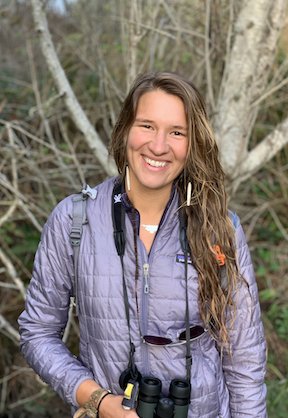
RAPTOR ECOLOGY SPECIALIST - ZOEY GREENBERG
RETURN TO HANOVER BALD EAGLE BLOGS
WATCH THE HANOVER BALD EAGLE LIVE CAMS
For over 20 years, HDOnTap has provided live streaming solutions to resorts, amusement parks, wildlife refuges and more. In addition to maintaining a network of over 400 live webcams, HDOnTap specializes in design and installation of remote, off-grid and otherwise challenging live streaming solutions. Contact press@hdontap.com for all media needs, including images and recordings.